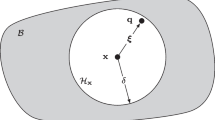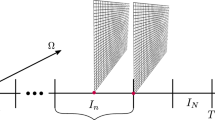Abstract
Starting from an abstract mathematical notion of discrete function spaces and operators, we derive a general abstraction for a large class of grid-based discretization schemes for stationary and instationary partial differential equations. Special emphasis is put on concepts for local adaptivity and parallelization with dynamic load balancing. The concepts are based on a corresponding abstract definition of a parallel and hierarchical adaptive grid given in Bastian et al. (Computing 82(2–3):103–119, 2008). Based on the abstract framework, we describe an efficient object oriented implementation of a generic interface for grid-based discretization schemes that is realized in the Dune-Fem library (http://dune.mathematik.uni-freiburg.de). By using interface classes we manage to separate functionality from data structures. Efficiency is obtained by using modern template based generic programming techniques, including static polymorphism, the engine concept, and template metaprogramming. We present numerical results for several benchmark problems and some advanced applications.
Similar content being viewed by others
References
Abdelaziz Y, Hamouine A (2008) A survey of the extended finite element. Comput Struct 86(11–12): 1141–1151
Arnold DN, Brezzi F, Cockburn B, Marini LD (2002) Unified analysis of discontinuous Galerkin methods for elliptic problems. SIAM J Numer Anal 39(5): 1749–1779
Bangerth W, Hartmann R, Kanschat G (2007) deal.II—a general-purpose object-oriented finite element library. ACM Trans Math Softw 33(4):24, 27
Bastian P, Birken K, Johannsen K, Lang S, Neuss N, Rentz-Reichert H, Wieners C (1997) UG—a flexible software toolbox for solving partial differential equations. Comput Visual Sci 1: 27–40
Bastian P, Blatt M, Dedner A, Engwer C, Klöfkorn R, Kornhuber R, Ohlberger M, Sander O (2008) A generic grid interface for parallel and adaptive scientific computing. II: Implementation and tests in dune. Computing 82(2–3): 121–138
Bastian P, Blatt M, Dedner A, Engwer C, Klöfkorn R, Ohlberger M, Sander O (2008) A generic grid interface for parallel and adaptive scientific computing. I: Abstract framework. Computing 82 (2–3): 103–119
Blatt M, Bastian P (2007) The iterative solver template library. In: Kagström B, Elmroth E, Dongarra J, Wasniewski J (eds) Applied parallel computing—state of the art in scientific computing. Springer, Berlin, pp 666–675
Brenner SC, Ridgway Scott L (2008) The mathematical theory of finite element methods. In: Texts in applied mathematics, 3rd edn, vol 15. Springer, New York
Brezzi F, Fortin M (1991) Mixed and hybrid finite element methods. Springer, Berlin
Burri A, Dedner A, Diehl D, Klöfkorn R, Ohlberger M (2006) A general object oriented framework for discretizing nonlinear evolution equations. In: Shokin YI, Resch M, Danaev N, Orunkhanov M, Shokina N (eds) Advances in high performance computing and computational sciences. Notes on numerical fluid mechanics and multidiciplinary design (NNFM), vol 93. Springer, Berlin
Burri A, Dedner A, Klöfkorn R, Ohlberger M (2006) An efficient implementation of an adaptive and parallel grid in dune. In: Krause E, Shokin YI, Resch M, Shokina N (eds) Advances in high performance computing and computational sciences. Notes on numerical fluid mechanics adn multidisciplinary design (NNFM), vol 91. Springer, Berlin
Castillo P, Rieben R, White D (2005) FEMSTER: an object-oriented class library of high-order discrete differential forms. ACM Trans Math Softw 31(4): 425–457
Ciarlet PG (1987) The finite element methods for elliptic problems. North-Holland, Amsterdam
Cockburn B, Shu C-W (2001) Runge-Kutta discontinuous Galerkin methods for convection-dominated problems. J Sci Comput 16(3): 173–261
Davis TA (2004) Algorithm 832: UMFPACK v4.3—an unsymmetric-pattern multifrontal method. ACM Trans Math Softw 30(2): 196–199
Dedner A, Klöfkorn R (2008) A generic stabilization approach for higher order Discontinuous Galerkin methods for convection dominated problems. Preprint no. 8. Submitted to SIAM Sci. Comput. Mathematisches Institut, Unversität Freiburg. http://www.mathematik.uni-freiburg.de/IAM/homepages/robertk/postscript/dedner_kloefkorn_limiter.pdf
Dedner A, Luethi M, Albrecht T, Vetter T (2007) Curvature guided level set registration using adaptive finite elements. In: Hamprecht F, Schnorr C, Jahne B (eds) Proceedings of the 29th annual symposium of the German association for pattern recognition. Springer, Berlin
Dedner A, Rohde C, Schupp B, Wesenberg M (2004) A parallel, load balanced mhd code on locally adapted, unstructured grids in 3d. Comput Visual Sci 7: 79–96
Diehl D (2007) Higher order schemes for simulation of compressible liquid-vapor flows with phase change. PhD thesis, Universität Freiburg. http://www.freidok.uni-freiburg.de/volltexte/3762/
Dune Fem Dune-Fem—The FEM Module. http://dune.mathematik.uni-freiburg.de/
Eymard R, Galluoët T, Herbin R (2000) Finite volume methods. In: Handbook of numerical analysis, vol VII. North-Holland, Amsterdam, pp 713–1020
Gerbeau J-F, Perthame B (2001) Derivation of viscous Saint–Venant system for laminar shallow water; numerical validation. Discrete Contin Dyn Syst Ser B 1(1): 89–102
Gersbacher C (2008) Local Discontiunous Galerkin Verfahren zur Simulation flacher dreidimensionaler Strömungen mit freier Oberfläche. Diploma thesis, Universität Freiburg
Haasdonk B, Ohlberger M (2008) Reduced basis method for finite volume approximations of parametrized linear evolution equations. M2AN Math Model Numer Anal 42(2): 277–302
Henning P, Ohlberger M (2009) Advection diffusion problems with rapidly oscillating coefficients and large expected drift. Part 2: The heterogeneous multiscale finite element method. Technical report, University of Münster (to be submitted)
Karypis G, Kumar V (1999) A fast and highly quality multilevel scheme for partitioning irregular graphs. SIAM J Sci Comput 20(1): 359–392
Karypis G, Kumar V (1999) Multilevel k-way partitioning scheme for irregular graphs. SIAM Rev 41(2): 278–300
Kröner D (1997) Numerical schemes for conservation laws. Wiley, Stuttgart
Lehn ML (2008) FLENS A flexible library for efficient numerical solutions. PhD thesis, Fakultät für Mathematik und Wirtschaftswissenschaften, Universität Ulm. http://flens.sourceforge.net/
Leveque RJ (2002) Finite volume methods for hyperbolic problems. In: Cambridge texts in applied mathematics. Cambridge University Press, Cambridge
Patera AT, Rozza G (2007) Reduced Basis approximation and a posteriori error estimation for parametrized partial differential equations. MIT, Version 1.0, Copyright MIT 2006-2007. In: (tentative rubric) MIT Pappalardo Graduate Monographs in Mechanical Engineering (to appear)
Schmidt A, Siebert KG (2005) Design of adaptive finite element software—the finite element toolbox ALBERTA. Springer, Berlin
Veldhuizen T The object-oriented numerics page. http://www.oonumerics.org/oon/
Author information
Authors and Affiliations
Corresponding author
Additional information
Communicated by C.C. Douglas.
Rights and permissions
About this article
Cite this article
Dedner, A., Klöfkorn, R., Nolte, M. et al. A generic interface for parallel and adaptive discretization schemes: abstraction principles and the Dune-Fem module. Computing 90, 165–196 (2010). https://doi.org/10.1007/s00607-010-0110-3
Received:
Accepted:
Published:
Issue Date:
DOI: https://doi.org/10.1007/s00607-010-0110-3
Keywords
- DUNE
- Partial differential equations
- Finite elements
- Finite volumes
- Discontinuous Galerkin
- Software
- Abstract interface
- Generic programming
- C++
- Parallelization
- Adaptive methods
- Dynamic load balancing




